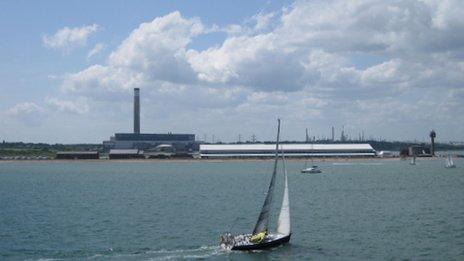Remembering 'landmark' Fawley Power Station ahead of demolition
- Published
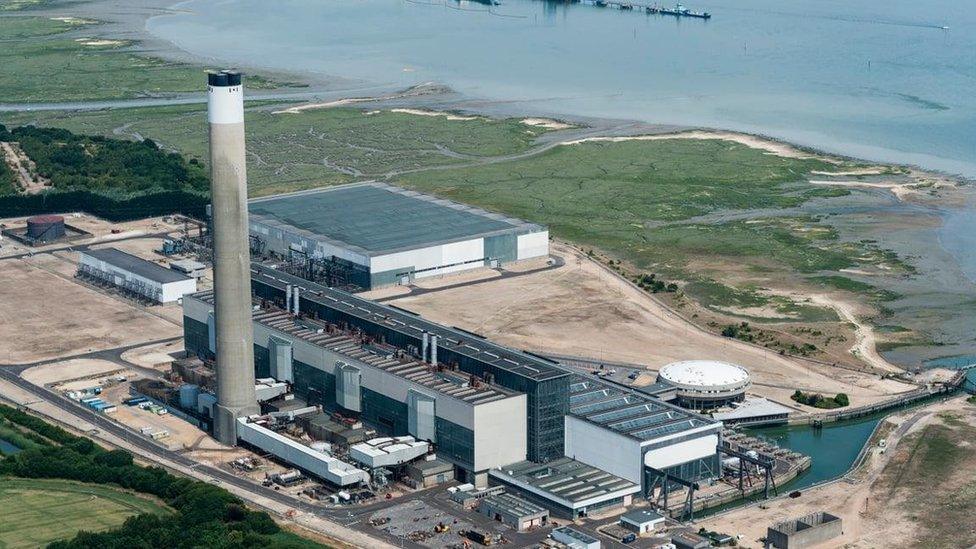
Fawley Power Station has dominated the western shore of Southampton water for more than 50 years
When the giant chimney of Fawley Power Station is demolished it will not only leave a gap in the Solent skyline, but will also mark the end of an era for many who worked there over more than 40 years.
For those employed at the oil-fired station on the western edge of Southampton Water, there was pride in an efficient, showpiece generator with a unique look and design.
It brings back toe-curling memories of working at the top of the 164m (680ft) stack for some, while film buffs may recognise it from Star Wars and Mission Impossible movies.
The chimney has been an ever-present landmark for anyone living or working along the south Hampshire and Isle of Wight coasts, a navigational aid guiding sailors back to Southampton, and was even used by the Red Arrows as a turning point during aerobatic displays.
Now demolition teams are set to blow it up on Sunday as the site is cleared to make way for a new residential development.
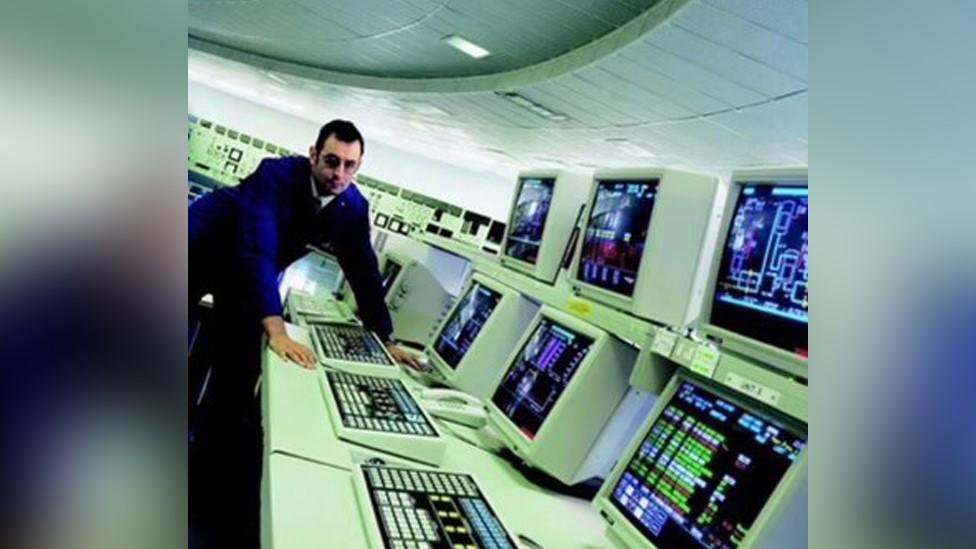
John Zarb progressed to become one of Fawley's senior engineers
John Zarb began working at Fawley as a 16-year-old maintenance apprentice in 1982 and progressed to become one of its senior engineers.
Two years later was the power station's peak year of output - a time when the miners' strike meant coal-fired power stations were at risk of running out of stocks.
It meant oil-fired power stations like Fawley were seen as crucial for Margaret Thatcher's government to keep the lights on during the bitter industrial dispute.
He recalled it as a "horrible time", with pickets outside the plant and "a lot of pressure from the government" to maintain output.
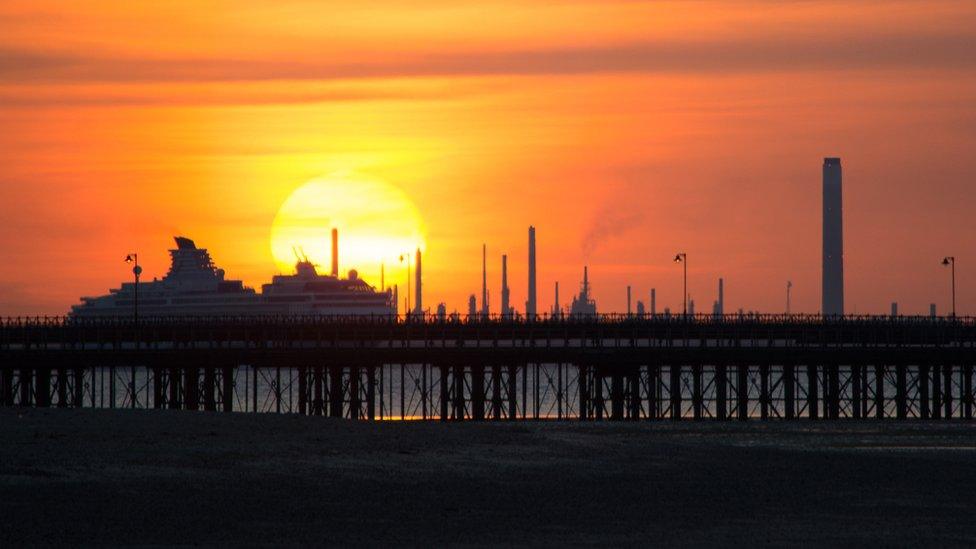
Pictured here from the Isle of Wight, the chimney of Fawley Power Station can be seen for miles around the Solent
Among the more unexpected experiences during his career, he recalled an undercover SAS training session involving a simulated raid on the power station.
"It was all secret and they never told the ops guys. One went in to check the cooling water tanks, only to be confronted by an armed SAS frogman.
"He came out a bit quicker than he went in," he said.
Mr Zarb's work also involved occasional trips to the top of the chimney in its internal lift.
"Its actually amazing how much the chimney moves.
"It was very noisy near the ground, but after about 30 seconds going up in the lift, the noise just disappears - it's silence and you feel removed from it all.
"At the top you are privileged to have fantastic views.
"There was no hand rail, just a six-inch lip. I'd crawl on my belly, and I could feel the wind on the soles of my shoes," he said.
Film locations
The futuristic look of the power station, in particular its circular "flying saucer" control room, made it an attractive location for TV and film producers.

The "flying saucer" control room was acclaimed as a prime example of brutalist architecture
In 2015 Mission Impossible 5: Rogue Nation was filmed on site, with one scene involving Rebecca Ferguson and Tom Cruise jumping from the turbine hall gantry crane to the basement 100ft (30m) below.
The same year an episode of the BBC's cult sci-fi comedy Red Dwarf Episode, entitled Give and Take, had scenes filmed inside the control room.
It also was used as one of the locations used for filming Solo: A Star Wars Story, released in May 2018.
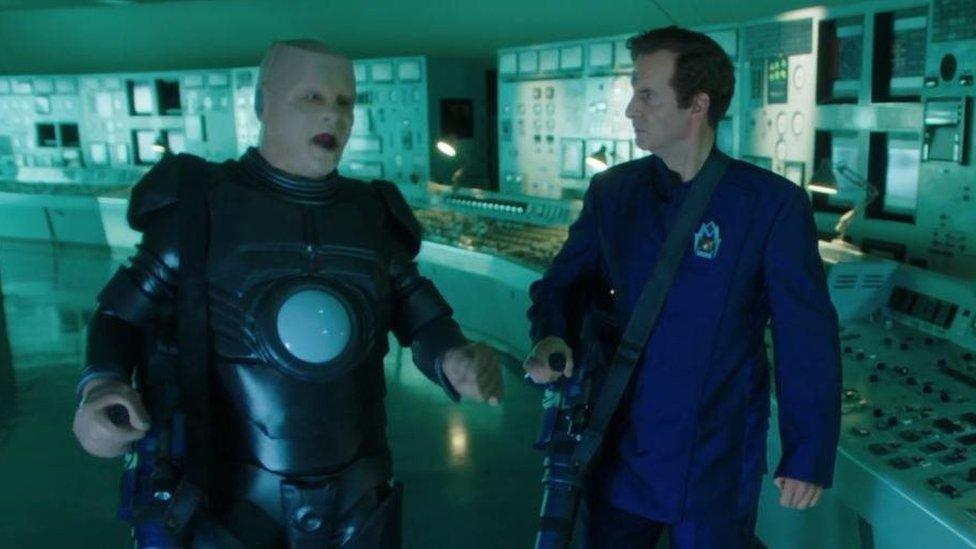
An episode of Red Dwarf was filmed inside Fawley's circular control room
The power station itself is also an unlikely subject for a stage play - writer David Lane is currently researching its history and compiling former employees' experiences for the The Forest Forge Theatre Company.
He said: "What surprised me was how much passion and value people put on it.
"It was a huge part of their lives and there are lots of personal attachments.
"Everyone talked about the scale and sense of industrial grandeur - the finish, the materials, the scale of it - how it was like nothing they'd ever seen before."
It is hoped the play - with the working title, Stacked - will begin touring later in 2023.
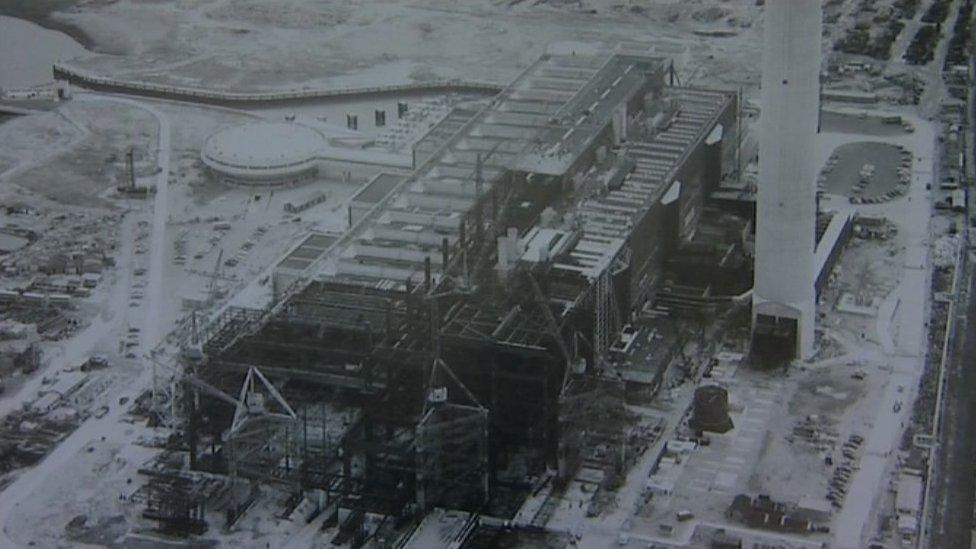
Fawley was built on reclaimed land on the shores of Southampton Water
'Attractive place'
Among those contributing to the play was 90-year-old Margaret Tillyer, who spent 40 years taking school trips, community groups and foreign dignitaries around the plant.
Despite having no engineering background, in 1972 she answered an advert looking for "well-educated local ladies, married or unmarried" to work as tour guides.
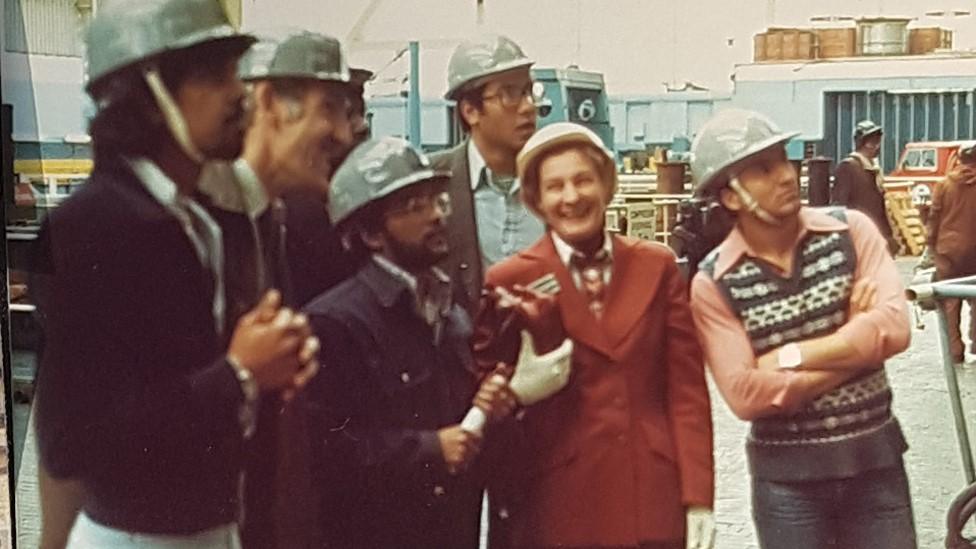
Margaret Tillyer was a tour guide at Fawley Power Station for 40 years
"It was a public relations job - I did learn the basic facts and could explain it all in comparatively simple English," she said.
In particular she said she wanted to inspire girls' interest in science and technology when she was leading school parties.
"I'd open up a door to show the wiring for the computers and would say 'anyone can do that, as long as you know what you are doing - that's a job to aim for for girls as well as boys'."
"With the sheer size and scale of the machines, it was easy to keep children's interest. I'd get them to touch the chimney so whenever they saw it in future, they could say 'I touched that'".

Fawley was designed to allow in natural light
Fawley's unique design features - in particular the triangular panels of marine-grade glass in the boiler house - meant Mrs Tillyer said she always considered it "a very attractive place".
"Visitors noticed that it was so big and airy, with very few people moving around.
"It was very calm, just with a whirling noise - people couldn't believe it was generating enough electricity for the south of England.
"It glowed - it was never a blot on the horizon - the glazing made it so perfect."
Mrs Tillyer said she would be watching from her street as the chimney comes down on Sunday.
"We were always told power stations don't last forever - they said it would only last 40 years. The whole world situation has changed.
"I am very sad about the control room though - I don't understand how such a unique architectural design could not be saved - there is very little respect for buildings which have been icons of our past," she said.
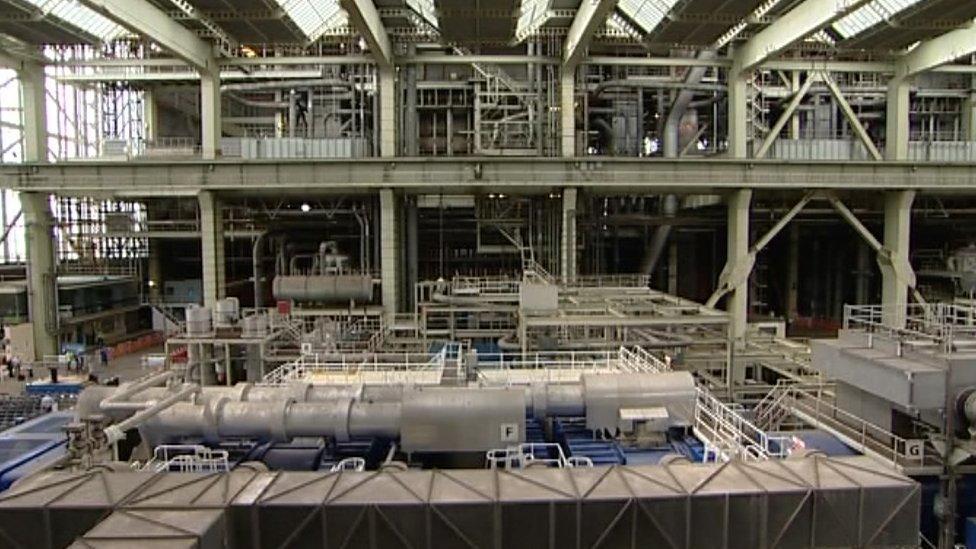
Fawley finally shut down in 2015
Fawley was part of the Central Electricity Generating Board's post-war plan for energy self-sufficiency when it was commissioned in 1971, but its fortunes ebbed and flowed with political, economic and environmental trends.
Built on reclaimed marshland on the edge of Southampton Water, it was set in a 20ft-deep trench, to lessen the visual impact.
It was intended to use oil left over from processing at the neighbouring Esso refinery.
However the oil crisis of the 1970s, when the international price rocketed, meant Fawley struggled to be economically viable in the long term.
Nevertheless it was one of the country's most efficient power generators in the 1970s and was still able to provide power for more than one million homes when needed, well into the 21st Century.
By the turn of the century, climate concerns were affecting power generation policy and oil-fired Fawley could not meet new emissions rules, meaning it had to close by 2015.
'Fall in love'
The power station has been an ever-present landmark for more than 40 years, but it is not only Hampshire residents who will feel its loss.
Marcella Klein lives in the Netherlands and has a self-confessed "lifelong passion for huge industrial plants".
She first came across Fawley while at the Southampton Boat Show in 1997 and has been a regular visitor to the power station ever since.
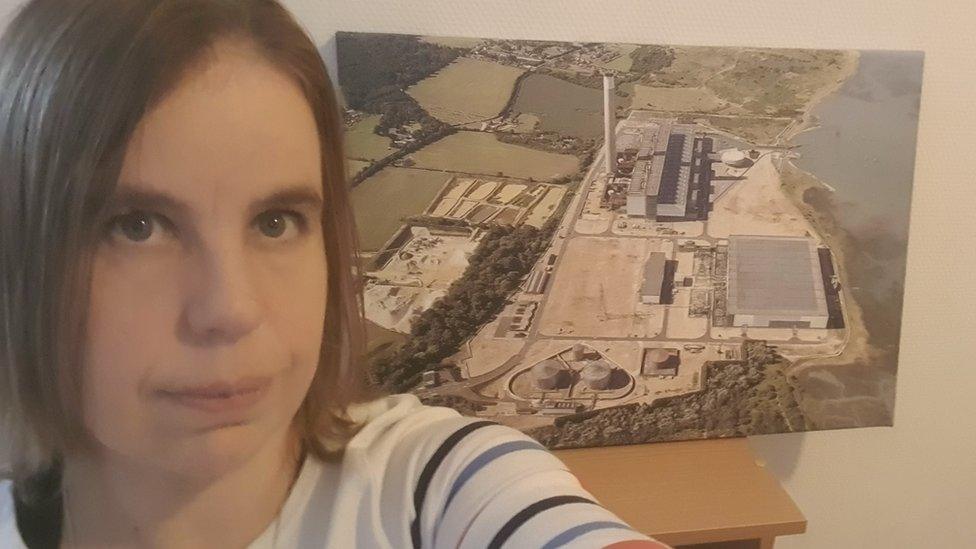
Marcella Klein made regular visits to Fawley from her home in the Netherlands
"I learned so much about the plant and its history - that fascination only grew and grew more.
"It made me fall in love with the place in some way and especially how the impressive and proud stack dominated and gave identity to the skyline."
She said she was "extremely angry" and would not be able to watch the demolition.
"The chimney is a landmark, guiding many people home - it is an absolute shame that such an important and iconic landmark that means so much for so many of us is destroyed," she added.
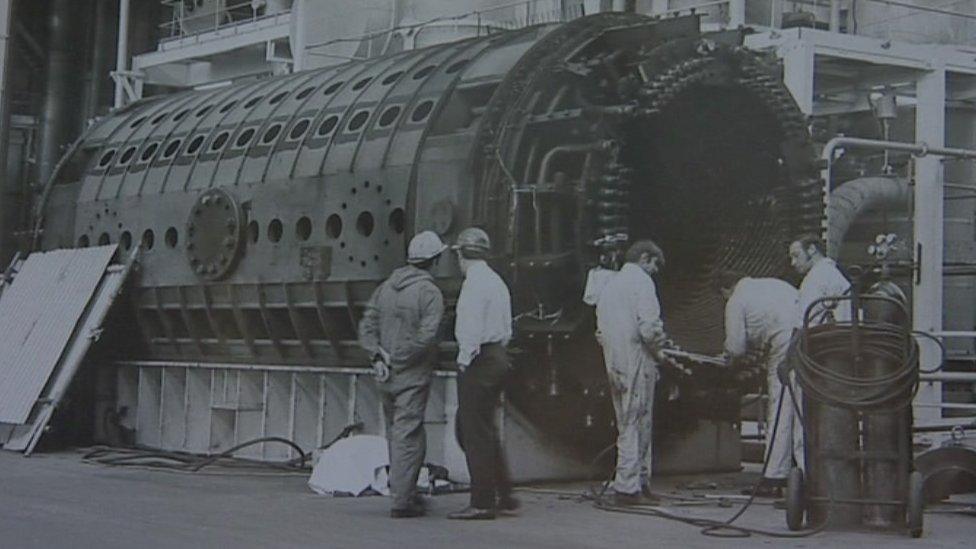
Fawley was the country's most efficient power station for several years in the 1970s

Follow BBC South on Facebook, external, Twitter, external, or Instagram, external. Send your story ideas to south.newsonline@bbc.co.uk, external.
Related topics
- Published29 July 2021
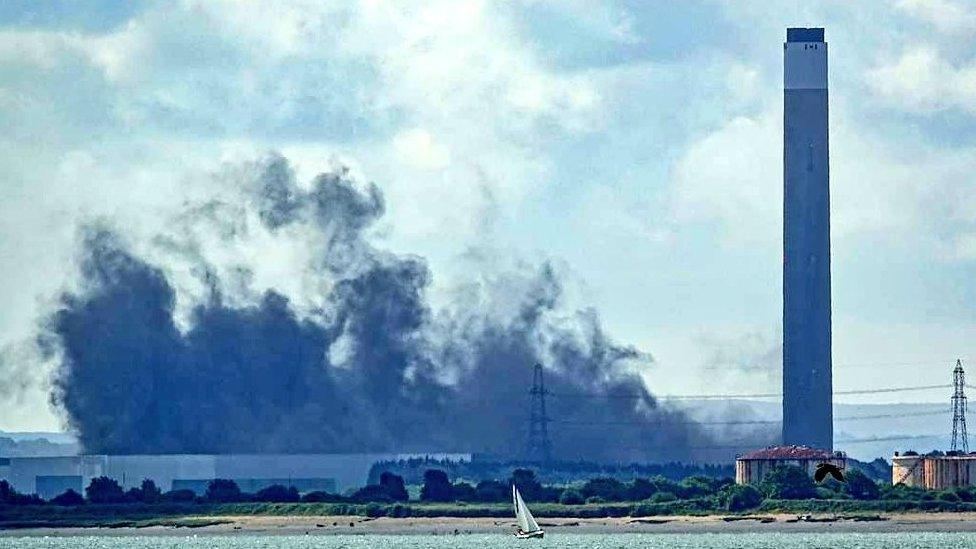
- Published2 April 2013
